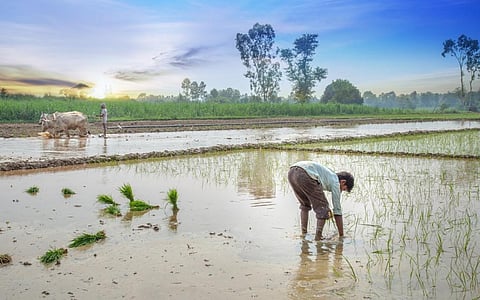

There is 13.27 per cent less area under paddy in 2022, compared to last year, even as the sowing of paddy was completed by the end of July in most parts of the country. Paddy is one of the main food grains grown in the kharif season that starts in June and ends in October.
Some 23.15 million hectares (mha) of paddy had been sown by July 29, 2022, according to data released by the Union agriculture ministry. This is 3.55 mha less than what was sown in 2021 during the corresponding period.
Read
The gap between paddy acreage in 2022 and in the ‘normal’ area under paddy by July end is much more — at 41.6 per cent. ‘Normal’ sown area for this time of the sowing season is 39.7 mha.
The target area under paddy for 2022 was higher, at 41.31 mha. The primary reason for the reduced sown area is the failure of the monsoon in the month of June and of its smooth progression in July in most parts of the country.
Two days ago, Union Minister for Agriculture and Farmers Welfare Narendra Singh Tomar, mentioned that there was a possibility of covering the shortfall in paddy sowing in the ongoing kharif season. However, that possibility looks bleak as the sowing of paddy usually gets over by now.
Less sown area has been reported from 17 states — West Bengal, Uttar Pradesh, Bihar, Jharkhand, Telangana, Odisha, Chhattisgarh, Tripura, Assam, Karnataka, Andhra Pradesh, Meghalaya, Haryana, Mizoram, Uttarakhand, Jammu and Kashmir and Sikkim.
Overall, the monsoon has been ‘above normal’ by eight per cent till July 31, according to data from the India Meteorological Department. But at least six of the leading rice-producing states — WB, UP, Bihar, Jhakhand, Mizoram and Tripura — have recorded a deficit rainfall, with many districts even recording a ‘large deficit’.
A few other important crops are also lagging behind in their acreage. In pulses, arhar (pigeonpea) which has the maximum area under the pulses basket in the kharif season has fallen short by 13.5 per cent, compared to last year.
The sowing has fallen in the top five arhar-producing states of Maharashtra, Karnataka, Madhya Pradesh, Gujarat and Uttar Pradesh. However, the overall area under pulses has increased by 0.29 mha, which is attributed to mostly higher production of moong (green gram).
The acreage of maize, another important kharif crop, has also fallen by around five per cent. The overall area under kharif crops has decreased by 1.82 mha, compared to 2021 and by 26 mha compared to ‘normal’ sown area by this time of the year.
June and July are the two most important months in which the farmers complete their kharif sowing, as 61 per cent of Indian farmers practice rainfed agriculture.
Down To Earth has been reporting how farmers across India have been unable to sow or have been losing their crops this kharif season, owing to low or no rainfall.
This also raises worry about India’s Public Distribution System (PDS), of which rice is main food item. Up to July 31, the Food Corporation of India has procured 589.78 lakh metric tonnes (LMT) in the kharif marketing season.
The current rice stocks are at 548.58 LMT (including unmilled paddy), much higher than the stocking norm as of July 1 at 135.40 LMT.
But this will be just enough to meet the total rice allocation of around 565 LMT under various schemes during 2022-23. And the situation has become only more complicated after the low wheat crop due to a scorching heat wave in March.
This resulted in a record drop (56.6 per cent) in the government’s wheat procurement for the rabi marketing season 2022-23. Already, wheat is being substituted with rice in many states after a cut in their wheat allocation under the National Food Security Act (NFSA), 2013.
Meanwhile, lower rice production has also led to rice prices showing an upward trend. According to latest data by the Union Ministry of Consumer Affairs, rice prices were at Rs 37.02 per kg as of July 31. They were Rs 36.41 per kg a month ago and Rs 35.55 a year ago.